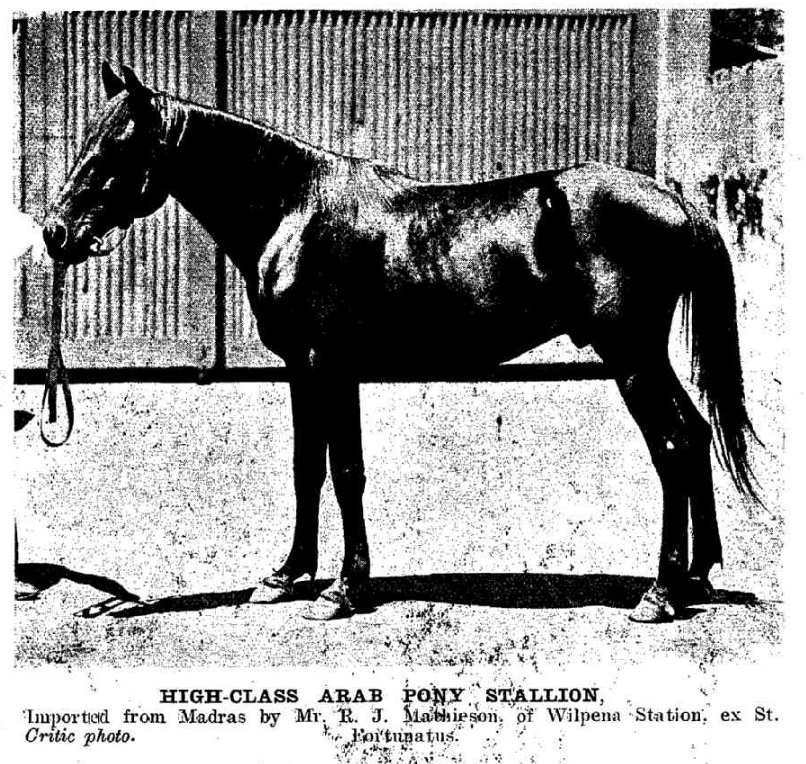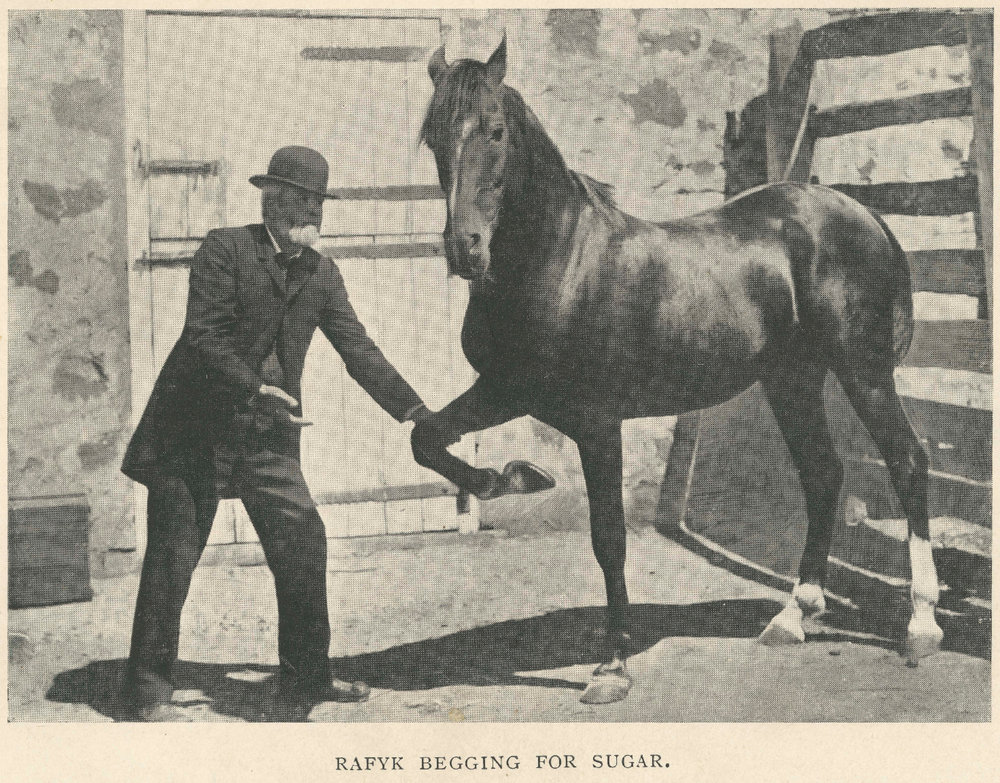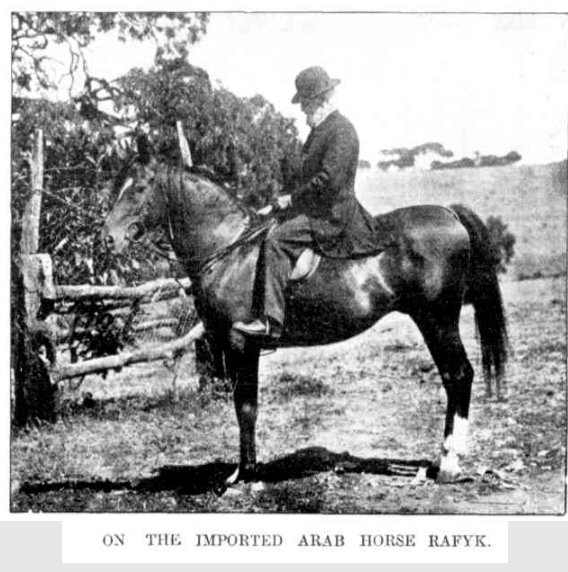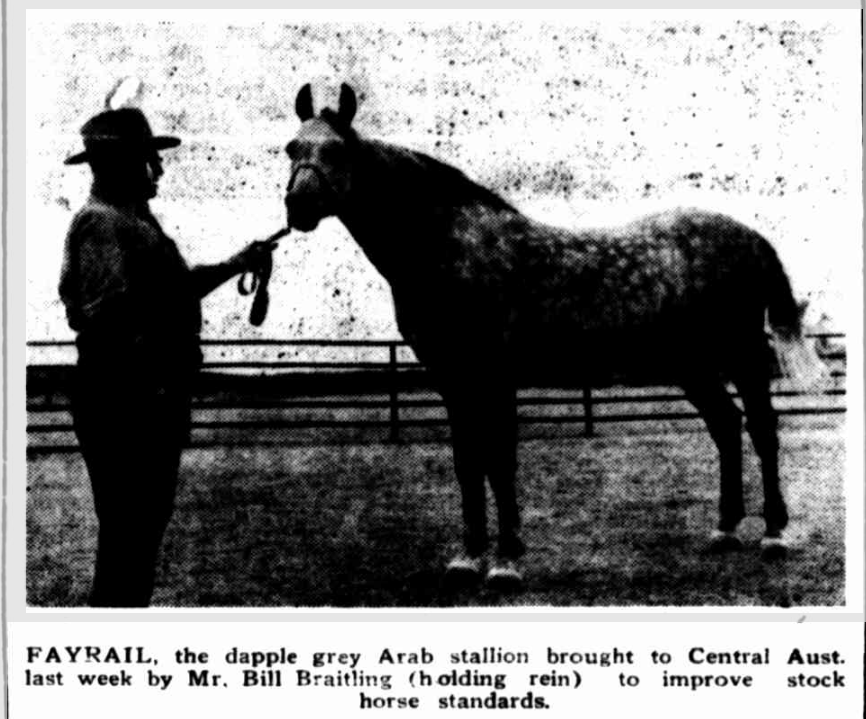Early Arab Horses NT

© Janet Lane, 2018. Image: Critic, Adelaide, Wednesday 13 January 1904.
Early Arab horses, Northern Territory (may be others not yet sourced)
1876 Yam Creek. A possible Arab horse of unknown gender.
“There was another horse race here last Monday. A distinguished prospector, bringing down a fine lot of horses, in a moment of excusable weakness ventured to blow a little bit about the paces of a certain small grey horse belonging to the stud, and offered to back him to run against any animal in the district. The challenge was taken up, and a match made to run the chesnut against the grey for £20 a side. In the race the chesnut had all his own way, the other being pulled up before the distance was half got over. This is another illustration of the old saying, “Every man takes his own geese to the swans.”
“Don’t you send me another horse, please. Pray do not think me rude when I say that your knowledge of the equine race does not appear to be profound. When you told me that the last animal you sent was one that you had taken over for a bad debt of £2, I suspected that the steed in question was not quite the fine upstanding charger you represented him to be. As he arrived he appeared as rotund as a beer cask. Now he looks like the said cask without the staves-the hoops being painfully visible. I fancy the Arab was got up to deceive the eye, and that his last feed before he was delivered to me was from a black-smith’s bellows. He certainly had a “blow out” of oxygen. ALONZA X BROWN.”
Northern Territory Times and Gazette, Saturday 2 September 1876. Note, this was the Yam Creek between Pine Creek and Adelaide River, a mine at the time, not the Yam Creek east south east of Alice Springs.
1879 Port Darwin Camp. The dapple grey stallion Batchelor at stud, his grand dam was an Arab mare. Batchelor’s sire was Stockwell. Batchelor had been the champion coaching stallion of Queensland.
1881 Darwin. “When some fatal accident occurs, owners of vicious, ill-conducted dogs will perhaps see the necessity of either keeping, them chained up, or training them not to rush after any conveyance or horseman who passes by their doors. Only on last Tuesday afternoon a dog belonging either to Mr Straton or Tuckwell rushed after Mr Whitelaw and Dr Morice, who were coming into town after enjoying an hour’s ride. Mr Whitelaw, although his horse fell, managed to keep his seat, but our worthy doctor who is known to be a good equestrian, was riding the “speckled Arab,” and was thrown to the ground, falling on his hands and face, his feet well up in mid air. The neighbors rushed out to render assistance. After a few minutes the doctor was able to rise, and managed to reach his home. When we made inquiries the following morning, we were informed he had suffered no serious injury and was attending to his usual professional duties.”
Northern Territory Times and Gazette, Saturday 22 January 1881.
1881 Darwin. “Mr. V. L. Solomon is a most amiable young man in private, but when he mounts the stump, as an auctioneer, it is dangerous to look at him. A friend of ours went to his sale of Timor ponies, etc, on Monday last, and almost bought two or three, but as none were a match for his milk white Arab, he passed. “
Northern Territory Times and Gazette , Saturday 20 August 1881.
1900 Erldunda. Arab stallion by Rafyk (Rafyk was 14.3hh) bought from Judge Boucaut (Sir James Penn Boucaut) by Richard Warburton of Erldunda, 300 k south of Alice Springs. The Judge’s Arabs had been purchased from the Blunts stud in England (Crabbet) and were of Syrian descent; his stud was Quambi Springs at Mt. Barker, South Australia.


Circa 1904-6 Willeroo. Two or three Judge Boucaut’s Arabs. Following news errs in that the Judge bought his horses out from England, not Arabia, 2 and the stallion is spelled Rafyk.
“For his Arab sires Mr. Pearce did not go further than the South of his own State, as he found all he wanted at the stud of Judge Boucaut, outside Adelaide, where the famous imported Arab Rafeyk is making a name for himself. Mr. Pearce secured two Arab sires, Iokton and another, but the latter was unfortunately bitten by a snake shortly after being sent out to the station, and his death was a serious loss to the plucky owner, who has spent so much money in an endeavour to put the horse-breeding industry on its feet in the Northern Territory. However, another Arab horse is now being procured to fill the vacancy caused by the death of the one referred to. Iokton, the horse now doing duty at Willeroo, is by Azenba out of Rose of Sharon. Azenba was by Rafeyk, the latter being imported from Northern Arabia by Judge Boucaut. Azenba is, therefore, a full brother to that great Arab sire Khummaburri now doing duty on Diamantina Lakes station in Western Queensland, the property of Messrs. Macartney and Percy, and to which I made reference in the Diamantina Lakes notes in a previous issue.”
Queenslander, Saturday 21 April 1906.
In 1913 five of Pearce’s horses were struck dead by lightning in a yard on Willaroo, an Arab stallion was one of them.
1916. The stallion Radium (Marksman – Duchess) was standing at Batchelor Farm. His grand dam was an Arab (Marksman was by Lennox out of an Arab mare). Duchess was by out Sussex of an unknown mare.
1935 Rosewood. Arab stallion to Rosewood station NT (100k from Kununurra , not far from the W.A. border) by owner J.A. (Jack) Kilfoyle. When the old station house was demolished by owners about 2008, they found the station horse book going back to 1934. Info here from news articles. The horse was bred on an Arab stud near Townsville and shipped over on the Marella to Darwin.
1938 Tipperary. Arab stallion put onto Tipperary Station for Harold Byrne. Tipperary is in the Top End, 36k east of Daly River, 55k south of Adelaide River. This was a dapple grey from Mr Charles Burrows stud bear Townsville. He was to go over King Rufus mares. Byrne had just acquired more land that year, surrendered by Vesteys, with hundreds of unbranded horses on it. 1939 Tipperary. Dapple grey Arab colt sent to Harold Byrne of Tipperary Station, by breeder Mr Burrows Arab stud near Townsville. Possibly same as above in a recycled news item.
1949 Mt Riddock.
“ARAB STALLION FOR MT. RIDDOCK. Purchase by Webb Bros.Messrs. Goldsbrough Mort Ltd. announce the sale of the Arab stallion 3 Golden Star to Messrs. Webb Brothers, of Mt. Riddock station. Golden Star is a four year old chestnut Arab stallion from the famous Anlabie holding in South Australia. He was bred at Callandale in the south-east of South Australia, being by Riyalan from Melanda. His grandsire was the famous Skowronek. Webb Brothers’ attempt to breed up their horses through Golden Star will be watched with interest and appreciation by Territorians.”
Centralian Advocate , Friday 4 March 1949. The Skowronek line came from Arab horses in Poland, and is of interest.
1953 Mount Doreen. The stallion Fayrial (spelling error in following news report)…
“AN ARAB FOR THE N.T. The Territory acquired a new ‘glamour boy’ this week. He is strong and sound of limb, graceful in movement, and a beautiful dapple grey, in colour. ‘Fayrail’ is his name — he is a magnificent Arab stallion, believed to be the first imported Arab ever to enter the N.T. ‘Fayrail’ arrived by rail on Saturday and was welcomed by his new owner, Mr. Bill Braitling, of Mount Doreen station. The cattleman bought him at a big, but undisclosed price, because he believes the Arab steeds would be the ideal type of stock horse for this country. The dapple grey beauty was born in 1945 on the stud owned by the Hon. Lady Wentworth, of Crabbert Park, Sussex, England. Lady Wentworth is the outstanding Arab breeder of England. He was later purchased by stud owner Mrs. McLean, of Victoria, who won first prize at the Royal Melbourne and Royal Sydney Shows with him in 1948 and 1951. ‘Fayrail’ has a pedigree form that dates back so far and has such a terrific list of Arab ancestors on it that it would fill an ‘Advocate’ to publish. Mr. Braitling and his son Wally were delighted with the Arab aristocrat. The station men believe Arabs have all the requirements for good Territory stock horses. Compact, speedy and with great stamina— he is just what is wanted,’ said Bill Baitling. With ‘Fayrail’ he hopes to help raise the standard of stock horses on his own, and later, other properties.”
Centralian Advocate, Friday 11 December 1953. Fayrial had previously been at Fenwick stud. He was imported from England in 1946; his breeding Fayal x Raxina. Several Arab stallions and mares, and thoroughbreds, were among the brumbies on Newhaven when it was taken up by Alex Coppock in 1958, including a grey Arab stallion (probably Fayrial). The others were probably what also came down from Mount Doreen. Fayrial would have been 12 years old in 1958. He was there well into the late 1960’s. (information from Alex Coppock to Simone McArdle 2018).

Fayrial went along the Tanami, and eventually lived on Newhaven station. note article spelled his name wrongly – it’s Fayrial.
1954. Mount Doreen. Bill Braiting of Mount Doreen buys two Arab mares, presumably from Fenwick as they are of their lines, for Mount Doreen. One was Al-Khari by Rakib (imp.) said to be out of Silver Moonlight – perhaps meant a Silver Moonlight mare? The other was Silamet by Silver Moonlight out of Al Khari.
Source: Centralian Advocate Friday 17th December 1954. There were two stallions named Silver Moonlight on Fenwick, both of Crabbet lines. One of the mares to Mount Doreen came with foal at foot. At the time he bought the Arabs Braitling also bought several Thoroughbred mares for Mount Doreen, their lines in news of the time.